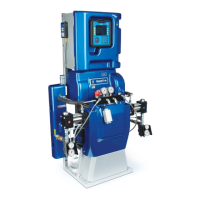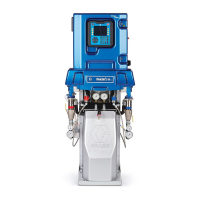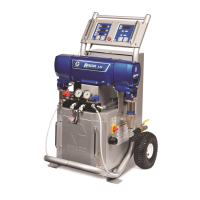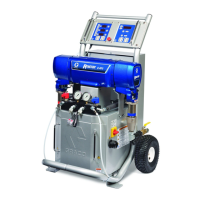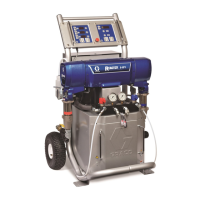Troubleshooting
PROBLEM CAUSE SOLUTION
Loose reversing proximity switch.
See Pumps Do Not Reverse
Direction, page 42.
Loose piston packing bolt. See Pumps Do Not Reverse
Direction, page 42.
Pumps do not reverse direction or
pumps do not move.
Faulty directional valve.
See Pumps Do Not Reverse
Direction, page 42.
Feed pump pressure is too low.
Adjus t press ure to ma in tai n 100 ps i
(0.7 MPa, 7 bar) minimum.
Pump cavitation.
Fluid is too thick. Consult your
material supplier for recommended
fluid temperature to maintain a
viscosity of 250 to 1500 centipoise.
Loose reversing proximity switch.
See Pumps Do Not Reverse
Direction, page 42.
Erratic pump movement.
Faulty directional valve. Replace directional valve.
Obstructed fluid hose or gun; fluid
hose ID too small.
Ope n fluid hose to clear obstruction,
or use hose with larger ID.
Worn pis ton valve or intake valve in
displacement pump.
Seepumpmanual.
Pump output low.
Inadequate feed pump pressure. Check feed pump pressure and
adjust to 100 psi (0.7 MPa, 7 bar)
minimum.
Fluid leak at pump rod seal. Worn throat seals.
Replace. See pump manual.
Fluid leaking from pump outlet
rupture disk.
Check if heater and PRESSURE
RELIEF/SPRAY valve (SA or SB)
are plugg ed. C lear. R eplace
rupture disk with a new one; do not
replacewithapipeplug.
No pressure on one side.
Inadequate feed pump pressure. Check feed pump pressure and
adjust to 100 psi (0.7 MPa, 7 bar)
minimum.
Note
Table 1 is related to troubleshooting problem,
“Proportioning pump does not hold pressure
when stalled.”
Table 1 Determine Valve Leak Location
B-side pump piston
valve is dirty or
damaged.
B-side pump inlet valve
is dirty or damaged.
A-side pump inlet valve
is dirty or damaged.
A-sidepumppiston
valve is dirty or
damaged.
Pressure/Material Imbalance
To determine which component is out of balance,
check the color of some sprayed material.
Two-component materials are usually a mix of
light and dark fluids, so the under-proportioned
component can often be readily determined.
When you have determined which component is
under-proportioned, spray off-target, focusing on the
pressure gauge for that component.
For example:
if component B is under-proportioned,
focus on the B-side pressure gauge. If the B
gauge reads considerably higher than the A gauge,
the problem is at the gun. If the B gauge reads
considerably lower than the A gauge, the problem
is at the pump.
334946A
41

